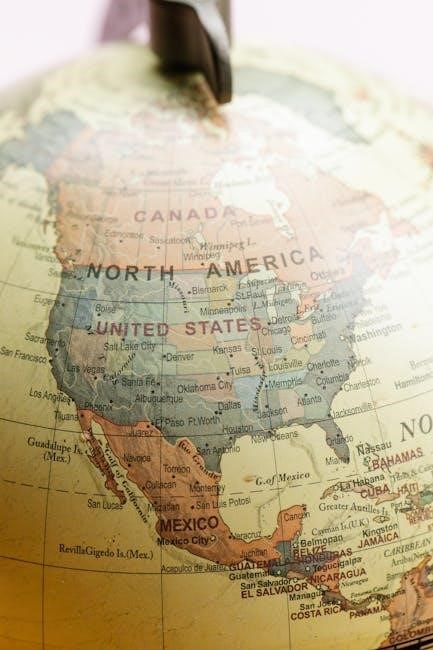Unit 6 Study Guide: World History
This unit explores the transformative period between 1750 and 1900, focusing on industrialization, imperialism, and their far-reaching social, economic, and political consequences worldwide.
Unit 6 delves into the transformative period of 1750 to 1900, examining the profound changes that reshaped global societies, economies, and political landscapes. This era marked the rise of industrialization, imperialism, and the emergence of new ideologies that influenced worldwide interactions. Key themes include technological advancements, economic shifts, social reforms, and the expansion of global connectivity. Students will explore how these developments interconnected and impacted different regions, fostering both progress and inequality. This unit provides a comprehensive understanding of the complexities of modernization and its enduring legacies in shaping the contemporary world.
Time Period: 1750 — 1900
The period from 1750 to 1900 was a time of significant transformation globally. It witnessed the Industrial Revolution, the rise of imperialism, and the emergence of new ideologies like nationalism and socialism. Technological innovations, such as the steam engine and telegraph, revolutionized industries and communication. This era also saw the expansion of global trade networks and the exploitation of colonial resources. Social changes, including urbanization and labor movements, reshaped societies. The period ended with the world on the brink of global conflicts, setting the stage for the complexities of the 20th century. Understanding this timeframe is crucial for grasping modern history.

Key Concepts and Themes
Central ideas include industrialization, imperialism, social Darwinism, and nationalism. These themes shaped global interactions, economic systems, and cultural exchanges during the 18th to 19th centuries.
Social Darwinism and Its Impact
Social Darwinism emerged as a justification for imperialism, using Charles Darwin’s theory of evolution to rationalize inequality and domination. It posited that certain races and societies were inherently superior, destined to dominate others. This ideology legitimized colonial exploitation, with colonizers viewing themselves as “civilizers” of “less evolved” cultures. Social Darwinism also fueled nationalism and competition among nations, as they sought to prove their superiority through expansion and economic dominance. Its impact was profound, shaping global power dynamics and perpetuating racial and social hierarchies during the 19th century.
The Civilizing Mission: Ideological Justification for Imperialism
The civilizing mission was a central ideology used to justify imperialism, asserting that European powers had a moral duty to “civilize” non-Western societies. Imperialists claimed to bring Christianity, education, and Western values to “backward” cultures, framing colonization as a noble endeavor. This ideology ignored the exploitation and violence inherent in imperialism, instead emphasizing the alleged benefits of Western influence. It also justified the imposition of European legal and political systems, often undermining local traditions and institutions. The civilizing mission became a powerful tool for legitimizing conquest and creating a moral rationale for global domination during the 19th century.
Technological Innovations
Key technologies like the steam engine, railways, and telegraph revolutionized industry, transportation, and communication, driving global connectivity and economic transformation during the 19th century.
The Steam Engine and Its Role in Industrialization
The steam engine, invented by James Watt, was a cornerstone of the Industrial Revolution. It replaced manual labor and water power, significantly increasing productivity in factories and mining. By harnessing steam power, industries achieved unprecedented efficiency, enabling mass production and economic growth. The steam engine also revolutionized transportation through locomotives and steamships, facilitating the movement of goods and people. Its widespread adoption marked a pivotal shift from agrarian to industrial societies, laying the foundation for modern industrialization and urbanization. This innovation was central to the transformation of economies and societies during the 18th and 19th centuries.
Development of Railways and Global Connectivity
The expansion of railways during the 19th century transformed global connectivity, enabling rapid transportation of goods and people across vast distances. Rail networks linked cities, facilitated trade, and strengthened economic interdependence between regions. In colonized areas, railways often served to extract resources for imperial powers, while in industrialized nations, they fostered urbanization and industrial growth. The integration of global markets through railways accelerated the exchange of cultures, ideas, and technologies, shaping the modern interconnected world. This development was crucial in bridging geographical divides and fostering economic and cultural exchange on an unprecedented scale.
The Telegraph: Revolutionizing Communication
The telegraph emerged as a groundbreaking innovation, revolutionizing communication by enabling rapid transmission of messages over long distances. Invented in the 19th century, it bypassed traditional postal systems, allowing instant exchange of information. This technology transformed global communication, facilitating business operations, political coordination, and personal correspondence. The telegraph played a crucial role in imperialism, enabling colonial powers to maintain control over distant territories. It also laid the foundation for modern telecommunications, connecting the world in ways previously unimaginable and fostering a sense of global interconnectedness that reshaped societies and economies forever.
Advancements in Manufacturing and Production
Advancements in manufacturing and production during the 18th to 19th centuries revolutionized industry. The steam engine, invented by James Watt, powered factories and machinery, increasing efficiency. Eli Whitney’s cotton gin and interchangeable parts streamlined production processes. The assembly line, pioneered by figures like Henry Ford, reduced production time and costs. These innovations enabled mass production, making goods more accessible and affordable. They also spurred industrial growth, urbanization, and economic transformation. However, these advancements often came at the expense of worker exploitation and environmental degradation, highlighting the dual nature of industrial progress during this period.
The Impact of Technological Progress on Society
Technological progress during the 18th to 19th centuries profoundly shaped society, improving quality of life and fostering global connectivity. Innovations like the telegraph and steam engine facilitated communication and transportation, enabling the movement of goods and ideas; Urbanization accelerated as people migrated to cities for factory jobs, leading to the growth of industrial centers. However, these advancements also widened social inequalities, as access to technology and its benefits remained concentrated among the wealthy. Additionally, technological changes disrupted traditional labor practices, spurring labor movements and social reforms aimed at addressing the challenges of industrialization.

Economic Transformations
Industrialization reshaped economies, fostering global trade, resource exploitation, and the rise of economic imperialism, while creating wealth disparities and interdependence between industrialized and colonized regions.
Industrial Capitalism and Its Spread
Industrial capitalism emerged as a dominant economic system, driven by factory production, wage labor, and capital accumulation. Originating in Britain, it spread globally, fueled by technological advancements and colonial resources. Key features included mass production, specialization, and investment in industries like textiles and steel. The expansion of railways and steam power facilitated the growth of global markets. However, this system also led to exploitation of workers, urban overcrowding, and significant wealth disparities. Industrial capitalism reshaped economies, creating new opportunities and challenges that defined the modern world during this period.
Global Trade Patterns and Economic Interdependence
Global trade patterns expanded significantly during this period, driven by industrialization and imperialism. Colonies became key suppliers of raw materials, such as cotton, rubber, and tea, while industrialized nations exported manufactured goods. The establishment of railways, steamships, and telegraphs facilitated faster and more efficient trade. Economic interdependence grew as nations relied on international markets for resources and goods. This interconnectedness shaped global power dynamics, with wealthy nations dominating trade networks while colonized regions often remained economically dependent. The expansion of global trade underscored the inequalities of the era, reinforcing economic disparities between industrialized and non-industrialized regions.
Exploitation of Resources in Colonies
Colonial powers aggressively extracted raw materials from colonized regions to fuel industrialization and economic growth in their home countries. Resources such as cotton, rubber, tea, and minerals were exploited to meet the demands of industrial production. Local populations often faced forced labor, land seizure, and displacement to facilitate resource extraction. This exploitation deepened economic disparities, as colonies became dependent on exporting raw materials while importing finished goods. The extraction of resources also led to environmental degradation and disrupted traditional livelihoods, further entrenching the inequalities of colonial rule and its lasting impact on global economic structures.
Economic Imperialism: Motives and Consequences
Economic imperialism was driven by the desire to secure new markets, raw materials, and investment opportunities. Colonizing nations sought to expand their economies by controlling resources and labor in colonies. This led to the extraction of wealth, often at the expense of local populations. Consequences included the enrichment of imperial powers, while colonies faced underdevelopment and dependency. Economic imperialism also fueled global competition, contributing to tensions that would later lead to conflicts like World War I. The economic motives behind imperialism reshaped global trade patterns and reinforced unequal power dynamics between colonizers and the colonized.

Social Changes
Industrialization brought urbanization, labor movements, and shifting roles for women, while social reforms addressed inequalities, reflecting a complex transformation in societal structures and norms during this period.
Urbanization and Its Effects on Society
Urbanization, driven by industrialization, led to rapid population growth in cities, creating overcrowded and unsanitary living conditions. This spurred the development of modern infrastructure and public services. While urban centers offered new economic opportunities, they also fostered social inequality and class divisions. The concentration of labor in cities fueled the rise of labor movements, demanding better wages and working conditions. Urbanization also catalyzed cultural shifts, as diverse populations interacted in unprecedented ways, shaping new social norms and identities. These changes laid the foundation for modern urban societies, highlighting both the benefits and challenges of industrialized city life.
The Rise of Labor Movements
The rise of labor movements during the 19th and early 20th centuries was a direct response to the harsh conditions of industrial capitalism. Workers faced long hours, low wages, and unsafe working environments, prompting the formation of unions and strikes to demand better treatment. Key events, such as the Lawrence Textile Strike and the growth of organizations like the American Federation of Labor (AFL) and the Industrial Workers of the World (IWW), highlighted the struggle for labor rights. These movements advocated for reforms, including shorter workdays, fair wages, and improved workplace safety, laying the groundwork for modern labor protections and regulations.
Changing Roles of Women in Society
The 19th and early 20th centuries saw significant shifts in women’s roles due to industrialization and social reforms. Women moved from traditional domestic roles into factory work, gaining economic independence but facing exploitation. The rise of feminist movements advocated for suffrage, education, and labor rights. Middle-class women increasingly participated in public life, while working-class women balanced factory work with household duties. These changes laid the groundwork for future gender equality efforts, challenging societal norms and paving the way for women’s greater participation in politics, education, and the workforce.
Social Reform Movements: Responses to Industrialization
Social reform movements emerged as responses to the challenges posed by industrialization. These movements addressed issues such as poor working conditions, child labor, and urban overcrowding. Reformers advocated for labor laws, improved public health, and education. Ideologies like socialism and liberalism influenced these efforts, pushing for systemic changes to reduce inequality. Governments and activists implemented policies to mitigate the harsh effects of industrialization, reshaping societal expectations and laying the groundwork for future reforms. These movements reflected a growing awareness of the need for social responsibility and ethical considerations in industrial societies.

Political Developments
Nationalism and nation-states rose, shaping political identities. Imperialism expanded, driven by political motives. Global conflicts intensified due to imperial rivalries and competition for resources.
Rationales for Imperialism: Political and Economic Motives
Imperialism was driven by political and economic motives, including the desire for national power, strategic territories, and resources. Nations sought to expand their influence and secure markets for raw materials and goods. Political leaders often justified imperialism as a means to strengthen their country’s global standing. Economically, colonies provided cheap labor and resources, fostering industrial growth. These rationales intertwined, creating a complex web of competition and exploitation that shaped global dynamics during this period.
The Rise of Nationalism and Nation-States
Nationalism emerged as a powerful force during the 18th to 19th centuries, emphasizing national identity, sovereignty, and unity. This ideology fueled the creation of nation-states, where governments represented a cohesive cultural and political entity. Nationalist movements often led to revolutions and independence struggles, reshaping political landscapes. The rise of nation-states was further supported by industrialization, which strengthened economies and military capabilities, enabling nations to assert dominance both internally and externally. This period marked a significant shift from diverse, fragmented territories to centralized, homogeneous nation-states, profoundly influencing global politics and societies.
Global Conflicts and Imperial Rivalries
During the 18th to 19th centuries, global conflicts and imperial rivalries intensified as European powers competed for colonies, resources, and influence. The Scramble for Africa and conflicts in Asia and the Pacific highlighted the clash of imperial ambitions. Economic interests, political power, and nationalist ideologies fueled these rivalries. Military build-ups and alliances further escalated tensions, setting the stage for global instability. These conflicts not only reshaped international relations but also laid the groundwork for future wars, including World War I, as nations sought to expand their empires and secure their interests in a increasingly interconnected world.

Environmental Impact
Industrialization caused significant environmental harm, including air and water pollution, deforestation, and resource depletion, leading to long-term ecological consequences during the 18th to 19th centuries.
Resource Depletion and Environmental Degradation
The rapid industrialization and imperialism from 1750 to 1900 led to massive resource depletion, as colonies were exploited for raw materials like timber, minerals, and agricultural products. This exploitation caused widespread environmental degradation, including deforestation, soil erosion, and loss of biodiversity; European powers, driven by economic gains, often disregarded sustainable practices, leading to long-term ecological damage. The overextraction of resources disrupted local ecosystems, affecting both colonized regions and the global environment, setting the stage for future environmental challenges.
Industrial Pollution and Its Effects
Industrialization from 1750 to 1900 led to significant environmental harm. Factories released large amounts of pollutants, including carbon dioxide, sulfur dioxide, and other harmful chemicals, into the air and water. The shift from organic to fossil fuel-based economies accelerated pollution levels, particularly in urban areas. This resulted in smog, acid rain, and contaminated water sources, negatively impacting public health and ecosystems. Urban centers faced severe air quality issues, while rivers became dumping grounds for industrial waste, causing widespread environmental degradation and early signs of climate change. These effects underscored the darker side of industrial progress during this period.
Early Conservation Efforts and Environmental Awareness
Amidst industrialization’s environmental toll, early conservation efforts emerged. Reformers and scientists began advocating for sustainable practices and resource management. Governments in Europe and North America established some of the first protected areas and regulations to limit pollution. Public awareness campaigns highlighted the consequences of deforestation, water contamination, and air pollution, sparking initial environmental movements. These efforts laid the groundwork for modern environmentalism, though their impact was limited compared to the scale of industrialization. They marked the beginning of a global conversation on balancing progress with ecological preservation.

Cultural Exchanges and Movements
- Westernization spread European ideas, technologies, and values globally, often imposing cultural dominance.
- Syncretic cultures emerged, blending local and foreign traditions, creating unique cultural identities.
- Intellectual movements like socialism and nationalism influenced societal change and political landscapes.
Westernization and Cultural Imperialism
Westernization and cultural imperialism were central to the spread of European ideas, values, and practices globally during the 18th to 19th centuries. This process often occurred through colonialism, where European powers imposed their culture on colonized societies, leading to the decline of indigenous traditions. Education systems, religious missions, and media were key tools for disseminating Western values. While some saw Westernization as a form of modernization, it frequently marginalized local cultures and reinforced inequality. Resistance to cultural imperialism emerged, as colonized peoples sought to preserve their identities. This cultural exchange, though often unequal, shaped global cultural landscapes.
Syncretic Cultures: Blending of Traditions
Syncretic cultures emerged as a result of cultural blending between colonizers and colonized peoples during the 18th to 19th centuries. This blending occurred due to colonialism, trade, and migration, leading to the fusion of traditions, beliefs, and practices. For example, Afro-Caribbean religions like Vodou and Santería combined African, European, and indigenous elements. Similarly, architectural styles in India blended British and Mughal influences. While syncretism fostered cultural richness, it also faced resistance from those who sought to preserve traditional identities. These blended cultures reflect the complex interactions and adaptations of the period, highlighting both collaboration and tension.
Intellectual Movements: Socialism, Liberalism, and Nationalism
The 19th century saw the rise of influential intellectual movements that shaped societal values and political ideologies. Socialism emerged as a response to industrialization, advocating for workers’ rights and equitable wealth distribution. Key figures like Karl Marx critiqued capitalism, inspiring movements for labor reform. Liberalism emphasized individual freedoms, constitutional governance, and free markets, influencing political systems globally. Nationalism, meanwhile, stressed national identity and sovereignty, often fueling unification movements and conflicts. These ideologies intersected and sometimes clashed, profoundly impacting political, social, and economic structures during this transformative period.

Global Inequality and Resistance
Colonial exploitation widened economic disparities, enriching colonizers while leaving colonies underdeveloped. Resistance movements emerged, as colonized peoples fought against oppressive systems, seeking independence and self-determination.
Economic Disparities Between Colonizers and Colonized
The exploitation of colonies by European powers led to significant economic disparities. Colonizers extracted raw materials and labor, enriching themselves while leaving colonies underdeveloped. Wealth from colonies funded industrial growth in Europe, while colonized regions remained impoverished. This economic imbalance perpetuated inequality, as colonies were denied opportunities for self-sustaining development. Resistance movements emerged as colonized peoples sought independence and self-determination, challenging the exploitative systems imposed by colonizers. These disparities laid the groundwork for long-term economic and social challenges in post-colonial nations.
Anti-Colonial Movements and Resistance
Colonized peoples actively resisted imperial rule through various movements, often driven by nationalism and the desire for self-determination. Leaders emerged to challenge colonial authorities, advocating for independence and cultural preservation. Resistance took many forms, including armed uprisings, diplomatic efforts, and non-violent protests. These movements highlighted the injustices of imperialism and demanded equality. Key examples include the Indian Independence Movement and African resistance against European rule. While some achieved immediate success, others faced repression, but all contributed to the eventual decline of colonial empires and inspired future liberation struggles worldwide.
Case Studies of Imperialism and Its Consequences
Case studies of imperialism reveal its devastating consequences on colonized societies. For example, British rule in India led to economic exploitation and cultural suppression, while the Belgian Congo became notorious for its brutal treatment of native populations; In Japan, the imposition of Western influence during the Meiji period reshaped its culture and politics. These examples highlight how imperialism disrupted traditional systems, often leading to resistance movements. The consequences of imperialism, such as loss of sovereignty and cultural erasure, had lasting impacts on global power dynamics and social structures, shaping modern international relations and cultural identities. Understanding these case studies is crucial for grasping the complexities of colonialism.

Legacy of Industrialization
Industrialization reshaped modern society, driving technological advancement and economic growth but also causing environmental degradation and social inequality, leaving a profound and lasting impact on global development.
Persistent Effects of Industrialization on Modern Society
Industrialization laid the foundation for modern society, influencing technology, urbanization, and global connectivity. It created new social systems, economic structures, and environmental challenges that persist today. Urban centers grew rapidly, fostering innovation but also inequality. Technological advancements continue to evolve, shaping industries and daily life. However, the environmental impact, such as pollution and resource depletion, remains a pressing issue. Industrialization’s legacy is evident in global trade networks and the interconnectedness of economies, emphasizing both progress and the need for sustainable practices to address its long-term consequences effectively.
Critiques of Industrialization and Its Consequences
Industrialization faced significant critiques for its negative social, environmental, and ethical consequences. Critics highlighted the exploitation of workers, poor working conditions, and the widening gap between the wealthy and the poor. Environmental degradation from pollution and resource depletion became major concerns. Additionally, industrialization was linked to imperialism, as nations exploited colonies for raw materials. Ethical issues arose regarding the treatment of labor and the concentration of power in the hands of industrialists. These critiques underscore the need for reforms and regulations to mitigate the harmful effects of industrialization while preserving its economic benefits.
Unit 6 highlights the transformative impact of industrialization and imperialism, emphasizing their far-reaching consequences on societies, economies, and cultures, shaping the modern world.
Review of Key Themes and Concepts
Unit 6 delves into the profound changes of 1750-1900, covering industrialization, imperialism, and their societal impacts. Key themes include technological innovations, such as the steam engine and railways, which revolutionized production and connectivity. Economic transformations like industrial capitalism and global trade reshaped economies. Social changes, including urbanization and labor movements, addressed inequalities. Political developments, like nationalism and imperialism, drove global conflicts. Cultural exchanges and environmental impacts round out the unit, providing a holistic view of this transformative era.
Final Thoughts on the Consequences of Industrialization
Industrialization between 1750 and 1900 reshaped global societies, economies, and politics. While it brought unprecedented progress through technological advancements and economic growth, it also led to significant challenges. Exploitation of resources, environmental degradation, and social inequalities marred its benefits. The rise of industrial capitalism fueled imperialism, creating power imbalances between colonizers and the colonized. Additionally, urbanization and labor movements highlighted the need for social reforms. Despite its drawbacks, industrialization laid the foundation for modern society, emphasizing the dual nature of progress and its consequences.

Study Tips and Resources
Utilize online flashcards, Kahoot links, and chapter notes for effective study. Review essential questions and engage with study guides to master key concepts and themes.
Essential Questions to Guide Your Study
What were the primary causes and consequences of industrialization? How did imperialism shape global economies and cultures? What role did nationalism play in shaping nations? How did technological innovations impact society? What were the social and economic effects of urbanization? How did labor movements and social reforms respond to industrialization? What were the key rationales for imperialism? How did global trade patterns influence economic interdependence? What were the environmental impacts of industrialization? How did cultural exchanges shape global traditions? What were the legacies of industrialization on modern society? Use these questions to focus your study and understanding of Unit 6 topics.
Recommended Resources for Further Learning
- Use Quizlet flashcards to memorize key terms like nationalism, imperialism, and industrialization concepts.
- Review the Kahoot link provided for interactive practice on Unit 6 topics.
- Consult AP World History textbooks, especially chapters 31 and 32, for detailed explanations.
- Explore study guides from College Board and other trusted sources for comprehensive reviews.
- Engage with online lectures and discussion forums to deepen your understanding of industrialization and imperialism.



